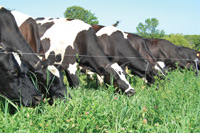What is your neighbor doing that you aren’t?
By Daniel Olson
Lena, Wisconsin — I know this is just a figure of speech, but there are times when your neighbor’s pastures look greener than yours. Or at least they seem to be substantially better. We all know that he isn’t smarter than you (he probably doesn’t even subscribe to this magazine) and he doesn’t work any harder (his barn lights don’t go on until 5:45 in the morning).
But there, on the other side of the fence, are some wonderfully beautiful pastures. Not only is this contrast embarrassing, it is expensive. If you are wondering how that neighbor got his pastures to grow so well, the following may include a few of his secrets.
1. He put his nitrogen on in the fall.
Most graziers think of applying nitrogen to their pastures in the spring, as this creates immediate results in terms of darkening the color and stimulating growth. Farmers like quick results.
But often this spring fertilizer will hurt summer pasture growth. Plant growth goes into overdrive when large amounts of nitrogen are applied in the spring. Research done in Virginia indicates that a grass plant’s energy reserves and root structure are depleted through this explosive growth period.
While annual yields are not that much different, the growth curve on spring-applied nitrogen is much more severe. The turf industry has known about the situation for a long time, which is why it now concentrates on applying nitrogen to lawns just prior to fall dormancy. This results in more tillering, denser stands and better drought tolerance the following summer. If it is the end of June and you are enviously comparing your browning pastures to your neighbor’s, it may be a nitrogen timing issue.
2. He manages residual.
I am becoming more convinced that residual management is the most important aspect of grass production. While differing species, soil types and geography create a lot of differing opinions on the amount of residue that should be left post-grazing, the research consensus is that adequate residue will make a much more resilient stand with improved summer production.
On our farm, fall grass residue is one area needing improvement. When we have left six or so inches in the fall, we have seen greatly improved spring growth. The temptation is great to run the cows through these paddocks one more time in the fall, and too often we succumb. We pay for this the following spring. Possibly this could be used as a tool to create our spring grazing wedge, but right now I’ll just call it bad management.
3. His pastures have lots of legumes.
Yes, we can grow grass without legumes, but it is hard to replace the synergy that happens when the two grow together. Research done at University of Minnesota showed an approximate 25% increase in first-year production on alfalfa/grass mixes when compared to the species being planted separately.
That may be the difference between having adequate pasture for your herd this summer, or not. Most agronomists attribute only 50-100 units of N fixation to a legume stand, but my experience is that we need to put much higher amounts of nitrogen on the grass if it comes from fertilizer. The efficiency of a little nitrogen every day is so much better than one or two applications a year.
4. He planted improved varieties.
Native grasses tend to look very good early in spring. Bluegrass, quackgrass and crabgrass can make adequate- to good-quality pasture for short periods of time. The issue is that they mature rapidly and fail to re-grow. If your neighbor’s pastures are still growing in July, it may be because he has planted improved grasses. Although overall production and quality improve with European species and newer varieties, the difference is most noticeable in the second half of the grazing season.
5. His pastures are more diverse.
Crop diversity may be the next frontier in increasing production. For a trial on our farm last year, we planted 11 monoculture plots of grasses and legumes at a 20 lbs./acre seeding rate. A 12th plot was a mix of the previous 11 plots, planted at the same 20-lb. seeding rate.
The first-year results were amazing! The diverse plot had the second highest quality, while yielding 17% more than the best monoculture plot and 30% more than the average for all plots.
To put this in context, seed companies get ecstatic over yield bumps of 5% over competitors.
This response was a real eye-opener for me. I don’t know the science, but by having diversity I would assume that we are pulling fertility from various levels in the soil complex, layering in the above-ground canopy and (in the case of the alfalfa plots) filling in otherwise bare ground.
Leveling the growth curve is another reason for plant diversity. For example, while ryegrass and clover may have explosive spring and fall growth, alfalfa, improved orchardgrass, and meadow fescue may be more heat and drought tolerant.
This consistency may be what you are seeing when you enviously look over at your neighbor’s pastures this summer. Either that, or he’s just lucky.
Daniel Olson milks cows, sells seeds, and direct markets from his farm near Lena, Wisconsin.

